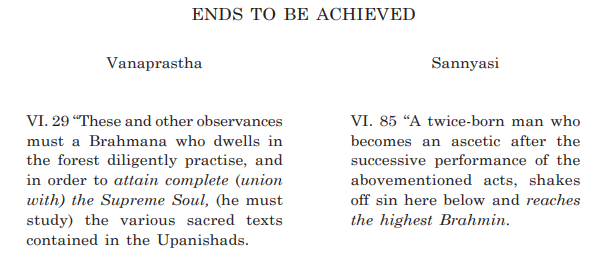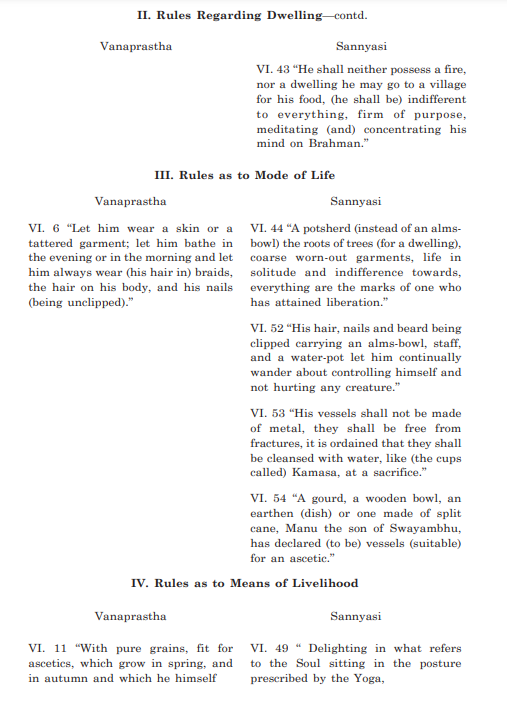Appendix II
Manu prescribes that an individual’s life on earth be divided into four stages. The four stages are: (1) Brahmacharya, (2) Grahasthashram, (3) Vanaprastha and (4) Sanyas. The stage of Brahmacharya is the stage of studentship—a period devoted to the study of the Vedas. The stage of Grahasthashram is the stage of married state or as Manu calls it the state of being an householder marrying and rearing a family. In the Vanaprastha stage the Vanaprastha ceases to be an householder in as much as he abandons his house. He, however, does not abandon his wife. He lives in jungle but does not give up his right to his property. He is dead in so far as the religious duties of an householder are concerned but he is not civilly dead. The stage of Sanyas is the stage in which a person breaks his marital tie, abandons his wife, gives up his wordly goods and leaves his household and does not follow the religious injunctions enjoined upon a householder and goes and lives in jungle to meditate upon Brahma. He is deemed to have committed civil death.
The division of man’s life into stages is an idea older than Manu.
What is important is the changes Manu has made in the scheme.
The first change Manu has made is that he has made marriage compulsory. A Brahmachari after he has finished his study must marry. This is the rule laid down by Manu as may be seen from the following:
2 (A student) “Who has studied in due order the three Vedas, or two, or even one only, without breaking (the rules of) studentship shall enter the order of householder.”
III. 4 “Having bathed, with the permission of his teacher, and performed according to the rule the Samavartana (the rite on returning home), a twice-born man shall marry a wife of equal caste who is endowed with auspicious marks.”
The second change Manu has made is to prohibit entry into the order of Sanyas for a Brahmachari who had not married. Marriage is made by Manu a condition precedent to Sanyas. He declares entry into Sanyas without having undergone the stage of marriage to be a sin.
VI. 35 “When he has paid the three debts, let him apply his mind to (the attainment of) final liberation; he who seeks it without having paid (his debts) sinks downwards.”
VI. 36 “Having studied the Vedas in accordance with the rule, having begot sons according to the sacred law, and having offered sacrifices according to his ability, he may direct his mind to (the attainment of) final liberation.”
VI. 37 “A twice-born man who seeks final liberation, without having studied the Vedas, without having begotten sons, and without having offered sacrifices, sinks downwards.”
VI. 38 “Having performed the Ishti, sacred to the Lord of creatures (Prajapati), where (he gives) all his property as the sacrificial fee, having reposited the sacred fires in himself, a Brahmana may depart from his house (as an ascetic).”
The third change made by Manu is to prohibit an householder from becoming a Sannyasi without first entering the stage of Vanaprastha.
VI. 1 “A twice-born Snataka, who has thus lived according to the law in the order of householders, may, taking a firm resolution and keeping his organs in subjection, dwell in the forest, duly (observing the rules given below).”
VI. 2. “When a householder sees his (skin) wrinkled, and (his hair) white, and the sons of his sons, then he may resort to the forest.
VI. 3. “Abandoning all food raised by cultivation, and all his belongings, he may depart into the forest, either committing his wife to his sons or accompanied by her.”
These changes made by Manu are of course revolutionary changes as compared with the rules which governed them before the time of Manu. On this point, I will only quote the relevant rules contained in two of the Dharma Shastras, the Vasistha Dharma Sutra and the Gautama Dharma Sutra.
Vasistha Dharma Sutra1 says:
“There are four orders viz., (that of) student, (that of) the householder, (that of) the hermit, and (that of) the ascetic.”
“A man who has studied one, two or three Vedas without violating the rules of studentship, may enter any of these (orders) whichsoever he pleases.”
Gautama Dharma Sutra1 says:
“ Some (declare, that) he (who has studied the Veda) may make his choice (which) among the orders (he is going to enter).”
“ (The four orders are, that) the student (that of) the householder, (that) of the ascetic (bhikshu) (and that of) the hermit in the woods (Vaikhanasa).”
As is clear from the two Dharma Shastras what order a person should enter after completing the stage of Brahmacharya is a matter which was left to his choice. If he wished he might marry and become as householder; or without entering into the marital state he might if so inclined straightaway enter into the order of a Sannyasi. That Manu in making matrimony a condition precedent for entry into the order of Vanaprashtha and Sannyas has made a revolutionary change is therefore quite obvious.
There is another change Manu seems to have made. One does not see why to reach Sannyasa after matrimony it was necessary to go through Vanaprastha. Why one could not straightaway become a Sannyasi. After all is there any difference between a Vanaprastha and a Sannyasi which can be called to be fundamental? In an excursus to this Chapter, I have collected together the rules made by Manu for regulating the conduct of the Vanaprastha and the Sannyasi. From a perusal of these rules it will be found that there is hardly any difference. Except the fact that the Vanaprastha is required to perform some of the religious duties and observances which are prescribed for the householders there is in substance no difference between men who have entered the two orders. It is equally true that the ends to be realized by the Vanaprastha and the Sannyasi are the same. How similar are the ends to be achieved by them can be seen by reference to the following texts from Manu.

Why then Manu carved out Vanaprastha as a separate stage from Grahasthashram and from Sannyas? Regarding Vanaprastha it can be said that such a class existed before Manu. They were called Aranas. According to Prof. Radha Kumud Mookerji1:
“Brahmacharis, who wanted to continue as such, without marrying in pursuit of knowledge, were called Aranas or Aranamans. These Aranas lived in hermitages in the forests outside the villages or centres of population. The forests where these Arana ascetics lived were, called Aranyas. The philosophical speculations of these learned ascetics regarding such ultimate problems as Brahma, Creation, Soul, or Immortality are embodied in works called Aranyakas.”
To these old Aranas Manu gave the name Vanaprasthas which has the same meaning as Aranas. Manu has not only made a change in names he has introduced another change of considerable significance. In between Brahmacharya and Vanaprastha he has introduced a married state. While the original Vanaprastha or Arana was an unmarried person, Manu’s Vanaprastha was necessarily a married man. In the old system Brahmacharya was followed by Vanaprastha or by Grahasthashram depending upon the choice of the individual. Manu changed the order, so that no one could become a Vanaprastha unless he was first married.
The old system, the two stages of Vanaprastha or Sannyasi, did not involve any hardship or cruelty to wives and children. The new system introduced by Manu did. For to force a person to marry and then to permit him to abandon his wife is nothing short of cruelty if it did not involve criminality. But Manu did not care for such considerations. He was bent on making matrimony compulsory for all.
Why did Manu do it? Why did he make Grahasthashram compulsory for a Vanaprastha or Sannyasi? Manu recognizes the married state as a superior stage the foundation of all other states. As he says:
VI. 87 “The student, the householder, the hermit and the ascetics, these (constitute) four separate orders, which all spring from (the order of) householders.
VI. 88 “But all (or even any of) these orders, assumed successively in accordance with the Institutes (of the sacred law), lead the Brahmana who acts by the preceding (rules) to the highest state.
VI. 89 “And in accordance with the precepts of the Veda and of the Smriti, the housekeeper is declared to be superior to all of them; for he supports the other three.
VI. 90 “As all rivers, both great and small, find a resting-place in the ocean, even so men of all orders find protection with householders.”
Granting the truth of this statement the question still remains why did Manu insist upon marriage as a condition precedent to Vanaprastha or Sannyas? The only answer is that he wanted to discourage persons, from becoming Sannyasi. Why did Manu dislike the order of Vanaprastha or Sannyasi? The answer is that the religion ofBuddhawas largely supported and propagated by Sannyasis called Bhikshus. It was easy for unmarried persons to become Bhikshus. Manu was anxious to stop this. Hence the condition of marriage.






This Article is taken from Babasaheb Ambedkar’s book Riddles in Hinduism

